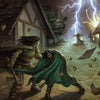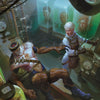How to Make Religion Matter in Your D&D Campaigns

By Luke Hart
In most Dungeons & Dragons games, religion shows up exactly once: when a cleric or paladin picks a deity during character creation. After that, it’s often forgotten, reduced to a name on the sheet and the occasional divine spell. But what if religion could be more than that? What if it became a meaningful, immersive part of your world—something that added tension, flavor, and story potential at every turn?
After decades of dungeon mastering, I’ve found that weaving religion into your campaign doesn't just enrich the game world—it deepens player engagement, provides memorable encounters, and unlocks unique plot opportunities. Today, I’m sharing 10 ways to incorporate religion into your D&D campaigns that go far beyond divine smite and healing spells.
1. Feature Religion in the Main Story Arc
Instead of leaving gods and demons in the background, bring them front and center. In one of my campaigns, a secret alliance between Asmodeus and the Queen of Air and Darkness served as the driving conflict—demons were being smuggled through the Feywild to help devils fight the Blood War. By threading divine conflict into the overarching plot, players were naturally drawn into researching lore, solving mysteries, and uncovering divine agendas. Just be sure to reveal religious elements gradually through story, not exposition dumps.
2. Let Religion Directly Impact the PCs
Make divine influence felt in the characters’ day-to-day lives. Maybe the local temple refuses to heal anyone due to unpaid tithes. Maybe a PC’s favorite NPC is arrested for blasphemy. When religion isn't just background noise—but a living force in the world—it becomes something players care about and want to engage with.
3. Highlight the Characters’ Chosen Religions
Clerics, paladins, and warlocks chose a deity or patron for a reason—make that choice matter. Reward roleplay aligned with their faith using inspiration or minor divine boons. In my game, one cleric built a church during downtime, gathered followers, and now leads a growing cult-like congregation. It’s added depth and fun to the character without derailing the main game.
4. Use Cults as Short-Term Religious Antagonists
If you want to bring religion into your game without dedicating the entire campaign to it, cults are your best friend. A heretical offshoot of a major religion can cause local strife and become the focus of a few sessions. In one of my campaigns, the White Knights of Torm claimed to serve good—but were secretly burning women they believed to be witches. It turned into a powerful narrative arc without taking over the whole story.
5. Tie Religion Into the Political System
When religion and politics mix, the results are compelling. A theocracy or state-sponsored church influences local law, social norms, and quest logistics. Even if the main plot has nothing to do with gods, a High Priest who must approve all adventuring activities adds tension, power struggles, and potential moral conflict.
6. Make Religion a Visible, Background Force
Even when religion isn’t front and center, it should still show up in the environment. Describe prayer ceremonies in the streets, festivals with divine origins, or monks passing by in silent procession. And if the players choose to interact with these moments, reward them with interesting lore, rumors, or even quest hooks.
7. Use Religious Organizations, Not Deities
It’s more interesting (and more manageable) to focus on priests, cults, and churches than to have gods intervene directly. Treat deities as distant, powerful forces working through mortal agents. This avoids the problem of players asking “Why can’t my god just fix everything?” and keeps the focus on the characters’ actions, not divine deus ex machina.
8. Make Religion Fantastical
This is a fantasy game—lean into it! Let the priest’s robes repel water supernaturally. Let divine sermons cause music to swell in the air. When you introduce religious figures, give them subtle magical effects and divine presence to make them feel otherworldly without turning them into stat blocks.
9. Add Nuance and Conflict to Religious Beliefs
Don’t assume every follower of a religion thinks the same way. Add different sects, internal disagreements, and outright schisms. Maybe two churches worship the same god but hate each other’s interpretations. Maybe a religion known for peace has a brutal inquisition arm. Conflicting beliefs create natural tension, great roleplay, and moral quandaries for your players to explore.
10. The Devil Is in the Details
Religious influence only feels real when it’s woven into the small things. Maybe priests always wear the same vestments—until one day they don’t. Maybe they greet people with a common religious phrase. Give your religions depth and flavor in subtle ways, and your world will feel alive, not just scripted.
The Ultimate D&D 5e Resource Anthology
Even as a veteran dungeon master, I'm often overwhelmed with everything I need to do to prep for a game. And I suspect others might feel the same way. That's exactly why my team and I created Lairs & Legends 2 and Loot & Lore 2.
If you’re looking for loads of 5e adventures that you can prep in under 30 minutes or elements such as traps, puzzles, and encounters that you can drag and drop into your game at a moment’s notice, we have you covered!
With Lairs & Legends 2 and Loot & Lore 2, you’ll get over 700 pages of D&D 5e resources:
- 33 Adventures
- 100+ Monsters
- Encounters
- Traps
- Puzzles
- and more!
Everything is designed to be EASY TO USE and QUICK TO PREP for your game. Our goal is to make game masters’ lives easier, not more complex!
Don’t spend another moment frustrated and overwhelmed as a GM. Pick up the Lairs & Legends 2 and Loot & Lore 2 today and find out how much easier being a GM can be!
-
Posted in
Game Master How-To Articles







